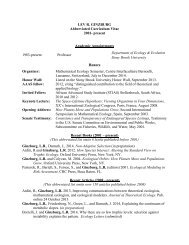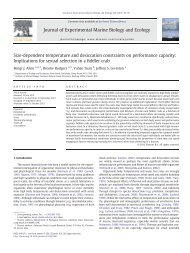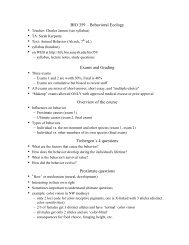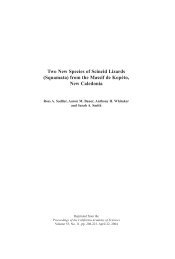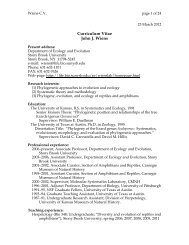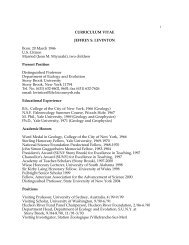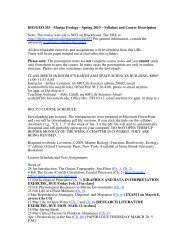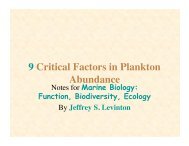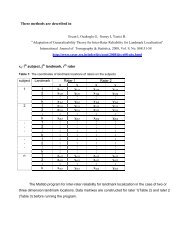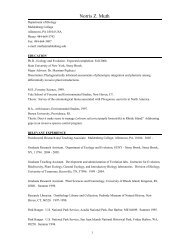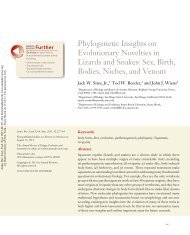1 Course Information and Syllabus Stony Brook University College ...
1 Course Information and Syllabus Stony Brook University College ...
1 Course Information and Syllabus Stony Brook University College ...
Create successful ePaper yourself
Turn your PDF publications into a flip-book with our unique Google optimized e-Paper software.
CLASS TIMES AND LOCATIONS<br />
Tuesday & Thursday 5:30 PM – 6:50 PM<br />
Melville Library E4330<br />
<strong>Course</strong> <strong>Information</strong> <strong>and</strong> <strong>Syllabus</strong><br />
<strong>Stony</strong> <strong>Brook</strong> <strong>University</strong><br />
<strong>College</strong> of Arts <strong>and</strong> Sciences<br />
Department of Ecology <strong>and</strong> Evolution<br />
BIO 336 Conservation Biology<br />
Fall 2012<br />
INSTRUCTOR AND TA CONTACT INFORMATION<br />
Instructor: Professor Liliana Dávalos<br />
Email: liliana.davalos-alvarez@stonybrook.edu<br />
Office Location: Life Sciences Bldg, 6th floor, Room 630<br />
Office Hours: Wednesday 10:30-12:30 <strong>and</strong> by appointment<br />
Teaching Assistant: Jin Gao<br />
Email: jingao@life.bio.sunysb.edu<br />
Office Location: Life Sciences Bldg, 6th floor, Room 633A<br />
Office Hours: Tuesday 10:00 AM – 12:00 PM <strong>and</strong> by appointment<br />
COURSE DESCRIPTION<br />
Society <strong>and</strong> individual lives are increasingly affected by environmental degradation at different<br />
scales. From the decline of local fisheries to global climate change, multiple crises threaten the<br />
biodiversity <strong>and</strong> ecosystems that sustain us humans. This course introduces the scientific<br />
foundations of conservation biology, along with examples from real-world conservation. The<br />
course reviews the biological concepts that underlie conservation including habitat<br />
requirements, population dynamics, biogeography, <strong>and</strong> population genetics. Analysis of case<br />
studies on the effects of human activities on biological diversity <strong>and</strong> ecosystem services will be<br />
used to explore the interdisciplinary nature of the practice of conservation. This course will<br />
prepare students for careers in environmental sciences <strong>and</strong> ecology.<br />
Credits: 3<br />
COURSE OBJECTIVES<br />
This is an undergraduate/masters lecture course focusing on biological concepts <strong>and</strong> methods<br />
underlying conservation practice. The course aims to:<br />
1. Exp<strong>and</strong> on fundamental concepts of ecology <strong>and</strong> evolution relevant to conservation.<br />
2. Build quantitative <strong>and</strong> analytical skills, including the application of simple models of<br />
population <strong>and</strong> community dynamics.<br />
3. Develop writing skills through writing, re-writing, <strong>and</strong> peer review.<br />
AMERICANS WITH DISABILITIES ACT<br />
If you have a physical, psychological, medical or learning disability that may impact your course<br />
work, please contact Disability Support Services, ECC (Educational Communications Center)<br />
Building, room128, (631) 632-6748. They will determine with you what accommodations, if any,<br />
are necessary <strong>and</strong> appropriate. All information <strong>and</strong> documentation is confidential.<br />
1
ACADEMIC INTEGRITY STATEMENT<br />
Each student must pursue his or her academic goals honestly <strong>and</strong> be personally accountable<br />
for all submitted work. Representing another person's work as your own is always wrong.<br />
Faculty are required to report any suspected instances of academic dishonesty to the Academic<br />
Judiciary. Faculty in the Health Sciences Center (School of Health Technology & Management,<br />
Nursing, Social Welfare, Dental Medicine) <strong>and</strong> School of Medicine are required to follow their<br />
school-specific procedures. For more comprehensive information on academic integrity,<br />
including categories of academic dishonesty, please refer to the academic judiciary website at<br />
http://www.stonybrook.edu/uaa/academicjudiciary/.<br />
In this class we will treat Academic Dishonesty harshly. What constitutes Academic<br />
Dishonesty? Academic dishonesty includes any act that is designed to obtain fraudulently,<br />
either for oneself or for someone else, academic credit, grades, or other recognition that is not<br />
properly earned or that adversely affects another's grade. The following represents examples of<br />
this <strong>and</strong> does not constitute an exhaustive list:<br />
• Cheating on exams or assignments by the use of books, electronic devices, notes, or<br />
other aids when these are not permitted, or by copying from another student.<br />
• Collusion: two or more students helping one another on an exam or assignment when it<br />
is not permitted. This includes sharing answers with others.<br />
• Ringers: taking an exam for someone else, or permitting someone else to take one's<br />
exam.<br />
• Submitting the same paper in more than one course without permission of the<br />
instructors.<br />
• Plagiarizing: copying someone else's writing or paraphrasing it too closely, even if it<br />
constitutes only some of your written assignment, without proper citation.<br />
• Submitting the same paper in more than one course without approval of the instructors.<br />
• Falsifying documents or records related to credit, grades, status (e.g., adds <strong>and</strong> drops,<br />
P/NC grading, transcripts), or other academic matters.<br />
• Altering an exam or paper after it has been graded in order to request a grade change.<br />
• Stealing, concealing, destroying, or inappropriately modifying classroom or other<br />
instructional material, such as posted exams, library materials, laboratory supplies, or<br />
computer programs.<br />
• Preventing relevant material from being subjected to academic evaluation.<br />
• Presenting fabricated excuses for missed assignments or tests.<br />
If you are found to violate the Academic Honesty st<strong>and</strong>ards, you will receive a zero (no<br />
credit) for any graded material <strong>and</strong> you will be reported to the Academic Judiciary. If you<br />
are found to violate Academic Honesty st<strong>and</strong>ards a second time, you will receive a<br />
penalty of 2 letter grades below your final grade, in addition to a zero on any graded<br />
material.<br />
CRITICAL INCIDENT MANAGEMENT<br />
<strong>Stony</strong> <strong>Brook</strong> <strong>University</strong> expects students to respect the rights, privileges, <strong>and</strong> property of other<br />
people. Faculty are required to report to the Office of Judicial Affairs any disruptive behavior that<br />
interrupts their ability to teach, compromises the safety of the learning environment, or inhibits<br />
2
students' ability to learn. Faculty in the HSC Schools <strong>and</strong> the School of Medicine are required to<br />
follow their school-specific procedures.<br />
EMERGENCIES<br />
If an emergency arises on campus during class, you are to remain in class until instructed to<br />
leave. The university emergency mechanisms <strong>and</strong> policy will apply.<br />
CLASS PROTOCOL<br />
• Unless otherwise instructed, please turn off all personal electronic devices. This includes<br />
cell phones <strong>and</strong> texting.<br />
• Do not check your email, phone/text messages, etc. during lectures. If you are expecting<br />
an urgent message or call, notify the instructor before the class.<br />
• Feel free to ask a question at anytime, but please do not talk to other students during<br />
lectures. It is disruptive <strong>and</strong> rude to other students.<br />
• Blackboard will be used extensively in this course for communication <strong>and</strong> assignments.<br />
You must have a Blackboard account with a valid, current email address. <strong>University</strong><br />
email access <strong>and</strong> addresses are free! You should log in as soon as possible <strong>and</strong> confirm<br />
your e-mail address.<br />
COURSE REQUIREMENTS<br />
GRADING<br />
Your grade will be based on:<br />
Item Percent<br />
Exam I 15<br />
Exam II 15<br />
Exam III 15<br />
Blog writing <strong>and</strong> peer review 25<br />
Assignments <strong>and</strong> exercises 25<br />
Participation 5<br />
COVERAGE OF EXAMS<br />
Each exam will be based on all information presented in prior lectures, readings, discussions,<br />
<strong>and</strong> exercises with the exception of the last lecture before the exam. The last exam will be<br />
based on all information presented in lectures, readings, discussions, <strong>and</strong> exercises. Exams will<br />
be designed to take 75 minutes.<br />
ATTENDANCE AND EXAM MAKE-UP POLICY<br />
If you miss an exam, or a take-home exercise because of an illness or emergency, you may be<br />
allowed to take a make up exam or assignment. Not having registered for the course at the<br />
time of a take-home exercise is not a valid excuse for not turning in the exercise. If you<br />
register late for the course <strong>and</strong> miss an assignment, you will not get credit for the missed<br />
assignment.<br />
You will need to present documentation verifying your excused absence. This must include a<br />
phone number <strong>and</strong> contact information. We will follow up with the information you provide.<br />
If you provide a false excuse or falsified documentation, you will be reported to the academic<br />
judiciary. You will also be given a zero (no credit) for the assignment or exam.<br />
3
BLOG WRITING<br />
Each student will select 1 topic <strong>and</strong> develop a blog entry presenting 1 scientific article on the<br />
relevant question, <strong>and</strong> communicating the findings to the public. You will be able to choose from<br />
a set of class-sourced topics. The scientific state of the art comes from the primary scientific<br />
literature, but the blog format is aimed at the general public (i.e., your retired relatives who did<br />
not complete degrees in science). The article that you will synthesize for the public can ONLY<br />
be found via Web of Science or Google Scholar.<br />
This writing assignment is NOT a term paper <strong>and</strong> term paper st<strong>and</strong>ards such as<br />
dictionary definitions, Wikipedia mining, <strong>and</strong> expounding on facts already reported in textbooks<br />
will not do. Blog writing will be an individual exercise. First draft of the blog entry will be due<br />
on 9/27, second draft on 10/18. Peer review of the drafts will begin immediately after<br />
submission. You have 1 week to complete peer reviews. The final, revised blog is due before<br />
the end of classes. Your blog entry can also count toward the writing requirement in the Biology<br />
major.<br />
PEER REVIEW<br />
We will implement peer-review of the blog items. Peer-review means you review the work of<br />
your peers, i.e., offer constructive criticism with the goal of improving their writing. Peer-review<br />
will count for 20% of your blog points in the class. Register into this system<br />
http://sword.lrdc.pitt.edu/sword/ <strong>and</strong> look for the class (BIO336 2012 at SBU). Use the class<br />
password “PlasmodiumRules” to register for the class. The system will enable you to submit<br />
your draft blog entries <strong>and</strong> review your peers’ work.<br />
ASSIGNMENTS AND EXERCISES<br />
Six individual take-home exercises with instructions will be posted on BB. The results <strong>and</strong><br />
interpretation of each exercise will be due one week after being assigned. A small number (4-5)<br />
of in-class group exercises will also be collected <strong>and</strong> count toward 33% of this grade. Graded inclass<br />
assignments will be announced during class.<br />
LATE ASSIGNMENTS<br />
It is imperative that you submit your work on time. Should you decide to submit your work late,<br />
the penalty will be 15% for each day your work is late. Beyond 7 days your grade for the work<br />
will be 0. This table does not apply to blog entries. Because those are peer-reviewed, they have<br />
hard deadlines that you must adhere to.<br />
PARTICIPATION<br />
Participation on weekly online forums will be counted toward 5% of your final grade. You will<br />
obtain the maximum score in this grade if you participate in the discussion forum posted with<br />
each discussion reading (9 total).<br />
EXTRA CREDIT OPPORTUNITY<br />
You will get 5 bonus points if you complete ALL surveys <strong>and</strong> assessments for the class. Some<br />
of the surveys <strong>and</strong> assessments will be posted online, <strong>and</strong> some will take place in class. Do<br />
them all <strong>and</strong> you will get these bonus points.<br />
DESCRIPTION AND SCHEDULE OF REQUIRED READINGS AND/OR ASSIGNMENTS<br />
Lecture titles <strong>and</strong> readings are listed for each day of class. Check Blackboard (BB) for updates<br />
<strong>and</strong> changes. Additional reading <strong>and</strong> web links will be found on BB. Check for updates, links to<br />
these sites <strong>and</strong> tips for using these sites. You must have a Blackboard account <strong>and</strong> a valid,<br />
current email address must be listed in your Blackboard account.<br />
4
<strong>Syllabus</strong><br />
The following is a schedule of lectures, exams, <strong>and</strong> assignments.<br />
Date Topic Learning<br />
objective<br />
28-<br />
Aug<br />
30-<br />
Aug<br />
4-<br />
Sep<br />
6-<br />
Sep<br />
11-<br />
Sep<br />
13-<br />
Sep<br />
18-<br />
Sep<br />
20-<br />
Sep<br />
<strong>Course</strong> introduction<br />
& student ethics.<br />
Active learning &<br />
blog topics.<br />
No classes<br />
Critical thinking<br />
assessment.<br />
Population:<br />
survivorship curves.<br />
Population: models<br />
& density<br />
dependence.<br />
Population:<br />
managing<br />
populations.<br />
Population:<br />
stochasticity.<br />
To identify ethical<br />
actions, <strong>and</strong><br />
distinguish from<br />
the opposite.<br />
To contrast<br />
learning via<br />
traditional lectures<br />
vs. active learning.<br />
To evaluate<br />
baseline critical<br />
thinking in class.<br />
To interpret <strong>and</strong><br />
plot survivorship<br />
curves, <strong>and</strong><br />
calculate life<br />
tables.<br />
To model the<br />
trajectory of<br />
populations using<br />
summary<br />
demographic<br />
parameters.<br />
To design<br />
management<br />
strategies based<br />
on population<br />
models.<br />
To evaluate the<br />
effects of<br />
stochasticity on<br />
Textbook reading Discussion<br />
reading<br />
How to read a scientific article (pdf)<br />
http://biology.kenyon.edu/Bio_InfoLit/index.html<br />
http://www.nature.com/scitable/knowledge/library/survivorship-curves-<br />
16349555<br />
http://www.nature.com/scitable/knowledge/library/how-populations-grow-theexponential-<strong>and</strong>-logistic-13240157<br />
http://www.eoearth.org/article/Carrying_capacity<br />
http://www.nature.com/scitable/knowledge/library/population-ecology-at-workmanaging-game-populations-50937864<br />
(Congdon et<br />
al. 1993)<br />
http://www.eoearth.org/article/Minimum_viable_population_size?topic=58074 (Frick et al.<br />
2010)<br />
5
25-<br />
Sep<br />
27-<br />
Sep<br />
2-<br />
Oct<br />
4-<br />
Oct<br />
9-<br />
Oct<br />
11-<br />
Oct<br />
16-<br />
Oct<br />
18-<br />
Oct<br />
23-<br />
Oct<br />
Genetics: genetic<br />
diversity.<br />
Genetics: HWE &<br />
mutation. First<br />
draft blog entry<br />
due.<br />
Genetics: genetic<br />
drift & migration.<br />
Genetics: natural<br />
selection. Reviews<br />
of peers due.<br />
Species<br />
interactions:<br />
infectious disease.<br />
Exam I<br />
Species<br />
interactions:<br />
competition.<br />
Species<br />
interactions: enemy<br />
release & invasion.<br />
Second draft blog<br />
entry due.<br />
Species<br />
interactions:<br />
consequences of<br />
populations.<br />
To relate genetic<br />
diversity to<br />
demography <strong>and</strong><br />
life history.<br />
To infer departure<br />
from equilibrium<br />
from observed<br />
gene frequencies.<br />
To contrast the<br />
effects of<br />
demographic<br />
processes on<br />
genetic diversity<br />
To assess the role<br />
of genetic diversity<br />
in future<br />
conservation.<br />
To model the<br />
impact of<br />
infectious disease<br />
on population<br />
dynamics.<br />
To asses the role<br />
of competition in<br />
shaping<br />
communities.<br />
To relate species<br />
interaction to<br />
biological<br />
invasion.<br />
To measure<br />
impact of invasion<br />
on communities<br />
http://www.nature.com/scitable/topicpage/mitosis-meiosis-<strong>and</strong>-inheritance-476<br />
http://www.nature.com/scitable/knowledge/library/the-hardy-weinbergprinciple-13235724 <br />
http://www.nature.com/scitable/topicpage/genetic-drift-<strong>and</strong>-effectivepopulation-size-772523<br />
(Hendrickson<br />
et al. 2003)<br />
http://www.nature.com/scitable/topicpage/negative-selection-1136 (Silva et al.<br />
2006)<br />
http://www.nature.com/scitable/knowledge/library/direct-<strong>and</strong>-indirectinteractions-15650000 <br />
http://www.nature.com/scitable/knowledge/library/ecological-consequences-ofparasitism-13255694 <br />
http://www.nature.com/scitable/knowledge/library/resource-partitioning-<strong>and</strong>why-it-matters-17362658<br />
http://www.eoearth.org/article/Invasive_species (Hochachka<br />
& Dhondt<br />
2000)<br />
http://www.nature.com/scitable/knowledge/library/conceptualizing-<strong>and</strong>evaluating-non-native-species-80060037<br />
6
25-<br />
Oct<br />
30-<br />
Oct<br />
1-<br />
Nov<br />
6-<br />
Nov<br />
8-<br />
Nov<br />
13-<br />
Nov<br />
15-<br />
Nov<br />
20-<br />
Nov<br />
22-<br />
Nov<br />
27-<br />
Nov<br />
29-<br />
Nov<br />
invasion. <strong>and</strong> ecosystems.<br />
Biogeography:<br />
biological<br />
communities.<br />
Reviews of peers<br />
due.<br />
No classes<br />
No classes<br />
Critical thinking:<br />
Intervention.<br />
Biogeography:<br />
species-area<br />
relationship.<br />
Biogeochemistry:<br />
carbon cycling.<br />
Exam II<br />
Biogeochemistry:<br />
more carbon<br />
cycling.<br />
No classes<br />
Economics: the<br />
global commons.<br />
Economics:<br />
microeconomic<br />
equilibrium<br />
&environmental<br />
To contrast<br />
populations <strong>and</strong> of<br />
communities.<br />
To practice critical<br />
thinking skills.<br />
To calculate<br />
species richness<br />
in isl<strong>and</strong> <strong>and</strong><br />
isl<strong>and</strong>-like<br />
habitats.<br />
To diagram major<br />
biotic components<br />
of carbon flows.<br />
To distinguish<br />
environmental<br />
goods from<br />
rival/excludable<br />
commodities.<br />
To interpret <strong>and</strong><br />
plot supply <strong>and</strong><br />
dem<strong>and</strong> curves,<br />
<strong>and</strong> identify<br />
http://www.nature.com/scitable/knowledge/library/sampling-biologicalcommunities-23676556<br />
http://www.nature.com/scitable/knowledge/library/the-conservation-of-mass-<br />
17395478<br />
http://www.nature.com/scitable/knowledge/library/soil-carbon-storage-<br />
84223790<br />
http://www.eoearth.org/article/Tragedy_of_the_Commons_(historical)<br />
pp. 52–54 in posted reading.<br />
http://www.eoearth.org/article/Supply_<strong>and</strong>_dem<strong>and</strong>?topic=49482<br />
(Torchin et al.<br />
2003)<br />
(<strong>Brook</strong>s et al.<br />
1999)<br />
pp. 71-73 in posted reading. (Kindermann<br />
et al. 2008)<br />
7
4-<br />
Dec<br />
6-<br />
Dec<br />
18-<br />
Dec<br />
externalities. Final<br />
version blog entry<br />
due.<br />
Economics:<br />
pollution markets.<br />
Critical thinking<br />
assessment.<br />
Reviews of peers<br />
due.<br />
environmental<br />
degradation as an<br />
externality.<br />
To design marketbased<br />
correctives<br />
to environmental<br />
externalities.<br />
To evaluate critical<br />
thinking after<br />
having taken the<br />
class.<br />
E4330 11:15 AM–1:45<br />
PM<br />
http://www.eoearth.org/article/Economics_of_climate_change?topic=49482<br />
8
Critical Thinking Rubric<br />
Modified from the AAC&U VALUE Rubric by The Network of Conservation Educators & Practitioners (NCEP)<br />
Critical thinking is a habit of mind characterized by the comprehensive exploration of issues, ideas, evidence, <strong>and</strong> events before<br />
accepting or formulating an opinion or conclusion. Levels of achievement (1-4) range from Beginning to Exemplary.<br />
Explanation of<br />
issues to be<br />
considered critically<br />
Evidence<br />
Selecting <strong>and</strong> using<br />
information to<br />
investigate a point of<br />
view or conclusion<br />
Influence of context<br />
<strong>and</strong> assumptions<br />
States the issue/problem without<br />
clarification or description.<br />
Selects evidence not relevant to<br />
the issue.<br />
1 2 3 4<br />
Takes information from source(s)<br />
without any<br />
interpretation/evaluation.<br />
Conflates cause <strong>and</strong> correlation,<br />
facts <strong>and</strong> opinion. Takes<br />
viewpoints of experts as fact,<br />
without question.<br />
Shows an emerging awareness<br />
of assumptions <strong>and</strong> context.<br />
Does not recognize context or<br />
assumptions <strong>and</strong> underlying<br />
implications, or does so<br />
superficially.<br />
States the issue/problem but<br />
description leaves some terms<br />
undefined, ambiguities<br />
unexplored <strong>and</strong>/or backgrounds<br />
unknown.<br />
Selects evidence somewhat<br />
relevant to the issue.<br />
Takes information with some<br />
interpretation/evaluation, but not<br />
enough to develop a coherent<br />
analysis or synthesis. Takes<br />
viewpoints of experts mostly as<br />
fact, with little questioning.<br />
Identifies some ways in which<br />
relevant contexts affect the<br />
issue. Acknowledges various<br />
sides of an issue. May be more<br />
aware of others’ assumptions<br />
than one’s own (or vice versa).<br />
States, describes<br />
<strong>and</strong> clarifies<br />
issue/problem so<br />
that underst<strong>and</strong>ing is<br />
not seriously<br />
impeded by<br />
omissions.<br />
Selects evidence<br />
mostly relevant to<br />
the issue.<br />
Takes information<br />
with enough<br />
interpretation/<br />
evaluation to<br />
develop a coherent<br />
analysis or<br />
synthesis. Questions<br />
viewpoints of<br />
experts.<br />
Identifies <strong>and</strong><br />
examines own <strong>and</strong><br />
other’s assumptions<br />
<strong>and</strong> several relevant<br />
contexts when<br />
describing/<br />
evaluating an issue.<br />
Clearly states <strong>and</strong><br />
comprehensively<br />
describes issue/problem<br />
delivering all relevant<br />
information necessary<br />
for full underst<strong>and</strong>ing.<br />
All evidence selected is<br />
relevant to the issue.<br />
Takes information with<br />
enough interpretation/<br />
evaluation to develop a<br />
comprehensive analysis<br />
or synthesis. Thoroughly<br />
questions viewpoints of<br />
experts.<br />
Fully analyzes <strong>and</strong><br />
synthesizes own <strong>and</strong><br />
others' assumptions.<br />
Carefully evaluates<br />
relevance of contexts<br />
when describing/<br />
evaluating an issue.<br />
Conclusions <strong>and</strong> Position is too simple or obvious. Position begins to acknowledge Position Position takes into<br />
9
elated outcomes<br />
Ability to make<br />
judgments <strong>and</strong> reach a<br />
position, drawing<br />
appropriate<br />
conclusions based on<br />
the available information,<br />
its implications <strong>and</strong><br />
consequences.<br />
Conclusion is inconsistently tied<br />
to the information discussed.<br />
Dismisses evidence without<br />
adequate justification. Related<br />
outcomes (consequences <strong>and</strong><br />
implications) are not mentioned,<br />
or oversimplified.<br />
complexity of an issue, such as<br />
different sides, knowledge gaps,<br />
or alternative solutions.<br />
Conclusion is logically tied to<br />
information, but evidence may<br />
be selected to bolster own<br />
arguments. Some related<br />
outcomes (consequences <strong>and</strong><br />
implications) are identified<br />
clearly.<br />
acknowledges<br />
complexity of an<br />
issue; refers to<br />
different sides,<br />
knowledge gaps,<br />
alternative solutions.<br />
Conclusion is<br />
logically tied to a<br />
range of information,<br />
including opposing<br />
viewpoints.<br />
Consequences <strong>and</strong><br />
implications) are<br />
identified clearly.<br />
account the complexity<br />
of an issue.<br />
Conclusions <strong>and</strong> related<br />
outcomes<br />
(consequences <strong>and</strong><br />
implications) are logical,<br />
reflect student’s informed<br />
evaluation <strong>and</strong> are<br />
qualified as the best<br />
available given evidence<br />
<strong>and</strong> context.<br />
10
Bibliography<br />
<strong>Brook</strong>s, T., J. Tobias, <strong>and</strong> A. Balmford. 1999. Deforestation <strong>and</strong> bird extinctions in the Atlantic<br />
forest. Animal Conservation 2:211-222.<br />
Congdon, J. D., A. E. Dunham, <strong>and</strong> R. C. Van Loben Sels. 1993. Delayed Sexual Maturity <strong>and</strong><br />
Demographics of Bl<strong>and</strong>ing's Turtles (Emydoidea bl<strong>and</strong>ingii): Implications for<br />
Conservation <strong>and</strong> Management of Long-Lived Organisms. Conservation Biology 7:826-<br />
833.<br />
Frick, W. F., J. F. Pollock, A. C. Hicks, K. E. Langwig, D. S. Reynolds, G. G. Turner, C. M.<br />
Butchkoski, <strong>and</strong> T. H. Kunz. 2010. An Emerging Disease Causes Regional Population<br />
Collapse of a Common North American Bat Species. Science 329:679-682.<br />
Hendrickson, S. L., R. Bleiweiss, J. C. Matheus, L. S. de Matheus, N. L. Jácome, <strong>and</strong> E. Pavez.<br />
2003. Low genetic variability in the geographically widespread Andean Condor. The<br />
Condor 105:1-12.<br />
Hochachka, W. M., <strong>and</strong> A. A. Dhondt. 2000. Density-dependent decline of host abundance<br />
resulting from a new infectious disease. Proceedings of the National Academy of<br />
Sciences, USA 97:5303-5306.<br />
Kindermann, G., M. Obersteiner, B. Sohngen, J. Sathaye, K. Andrasko, E. Rametsteiner, B.<br />
Schlamadinger, S. Wunder, <strong>and</strong> R. Beach. 2008. Global cost estimates of reducing carbon<br />
emissions through avoided deforestation. Proceedings of the National Academy of<br />
Sciences, USA 105:10302-10307.<br />
Luyssaert, S., E. D. Schulze, A. Borner, A. Knohl, D. Hessenmoller, B. E. Law, P. Ciais, <strong>and</strong> J.<br />
Grace. 2008. Old-growth forests as global carbon sinks. Nature 455:213-215.<br />
Silva, A., G. Luikart, N. Yoccoz, A. Cohas, <strong>and</strong> D. Allainé. 2006. Genetic diversity-fitness<br />
correlation revealed by microsatellite analyses in European alpine marmots (Marmota<br />
marmota). Conservation Genetics 7:371-382.<br />
Torchin, M. E., K. D. Lafferty, A. P. Dobson, V. J. McKenzie, <strong>and</strong> A. M. Kuris. 2003.<br />
Introduced species <strong>and</strong> their missing parasites. Nature 421:628-630.<br />
11



